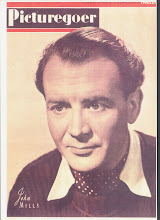Patricia Roc
My inclusion of Patricia Roc in this history of the Odeon came about purely by chance. About a month or so before I started this project I happened to see on TV the film ; "The Perfect Woman," at that point in time it was the only film of hers I'd seen.
Patricia Roc was born in 1918 in England . Her first film role came in the film The Gaunt Stranger (1938). One year later she'd improved her billing and appeared in The Rebel Son.
She became a more prominent British star of the forties, gaining a place in the Gainsborough Studios, where she along with other more remembered names of the forties became known as the Gainsborough Ladies. Gainsborough Studios later in life were taken over by the Rank Organisation.
In the mid forties Patricia Roc took the chance of going to Hollywood ; but she did make a promise to her British fans that she would return after completing Canyon Passage.
What may have pushed her to the point of leaving for America may have been the casting of films such as Love Story and The Wicked Lady. It seems that Patricia Roc had been "promised" the leading or bad girl roles in these films, but unfortunately these rolls were given to Margret Lockwood, so yet again Patricia only given the lesser parts.
Her travels did not end with America . She sought work in both France and Italy , always looking for that starring role.
In 1946 she made the film The Brothers, and on August the 17th 1947 the film had it's Scottish premier in the New Victoria. She along with Will Fyfe and Findlay Currie made a personal appearance on stage. While on stage Findlay Currie passed comment "that the Scottish Film Society did not do enough to promote Scotland and it's stars."
The Brothers, a stirringly emotional and striking British film of its time still could not compete against the American imports.
It was in 1949 Patricia made the film "The Perfect Woman." The film was screened in the New Victoria in June of the same year. The film also starred Nigel Patrick and Stanley Holloway. The story a simple idea. An inventor creates a robot woman, has a gentleman and his butler train the robot. The inventor's niece changes places with the robot and from then on the farce is played to a tee. In that one screening I saw I felt compelled to add it into my top ten, just through its sheer simplicity.
Patricia Roc carried on working right up until the 1960's, although she like Louise Brooks would never be recognised just the way she should.
Going back to the forties Patricia Roc, like other names from movies of the day became the face advertising different products of the day. These were the days before super models and it was actors and actresses that were the main stay of the faces seen advertising on billboards and in magazines.
One rumoured story of the forties that reared its head in newspapers and magazines of the day was also that American audiences had said that Britain didn't have any glamorous female stars.
We had Vivien Leigh, Ann Todd, Anne Crawford and Patricia Roc to name but a few. One comment was that we had leading Ladies, the Americans had "Dames."
In an article written in 1949 Patricia talked of the role she would most like to play again.
"I should like to go right back to the beginning of my career and play the part in which I really found my feet- namely that of Celia, the factory worker in Millions like Us.
If ever a movie captured the spirit of the moment, it was that simple story of people living and working on the home front in wartime. But if it was possible to turn back the clock, I'd like to think that in the light of subsequent experience I could do Celia greater justice.
Subscribe to:
Post Comments (Atom)







No comments:
Post a Comment